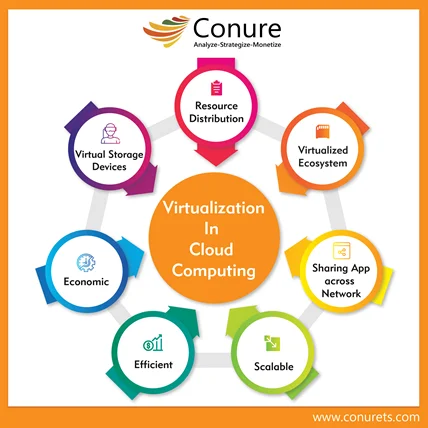Cloud Computing and Virtualization
Virtualization – A process to generate a computerized version of physical data centres, applications, various servers, and any hardware device counterparts. It creates software to manage the data over the online platform. However, it creates a layer between hardware components and users.
Virtualization software makes use of a thin version of the technology called a “hypervisor,” which enables a single computer to host multiple virtual technologies. Virtual machines (VMs) are software frames that run their software platforms and run as standalone computers, although with just a fraction of the fundamental infrastructure.
Though, Cloud computing is the supply of on-demand technology online services nevertheless on a compensation basis, ranging from apps to hardware resources.
How does Virtualization work in Cloud Computing?
Cloud computing in virtualizations are quickly incorporating the core virtual machines. One of the most essential features of cloud computing is that it enables many consumers and enterprises to share apps.
Cloud technology refers to the delivery of services and applications to aid in the virtualization of an ecosystem. This environment can be accessible or confidential. Virtualization allows customers to use resources while reducing the number of complex processes needed.
Virtualization in Cloud Computing technology is a mechanism through which a cloud consumer distributes the cloud resources, which might include programs, applications, and other types of data. It generates a new infrastructure on the cloud that can be made up of code, infrastructure, or anything else.
In hypervisor, the server-associated software applications that cloud computing providers require are shared among participating parties, and the cloud hosting pays a fee to the third party.
It is performed even though releasing the latest edition of the service and having to present it to clients will be costly.
Operating System Based Virtualization:
Depending on the operating system Virtualization is an operating system technology in which the kernel allows many segregated client entities to appear. Desktop virtualization deployment also refers to operational framework virtualization. It is placed on top of the standard file system, which is referred to as the hypervisor.
Towards this type of virtualization, a user installs virtualization software in his software like any other program and uses it to run and produce numerous virtual machine instances. Thus, the application virtualization gives the user easy access to either of the virtual servers that have been proven.
Operating system virtualization – affect hardware configuration difficulties even if the hardware license is not assigned to the virtualization software since the host OS might supply necessary support to hardware devices.
Virtualization software can turn hardware IT resources that use special programming into virtualized IT resources. Because the host OS is a full operating platform in and of itself, several Operating system organizational administrative and operational options are designed for virtualization dedicated server administration.
Businesses can use cloud-based applications with the use of virtualization in cloud technology. This blog proves how virtualization in cloud computing is an essential characteristic of cloud computing that could help to keep information safe and secure.





